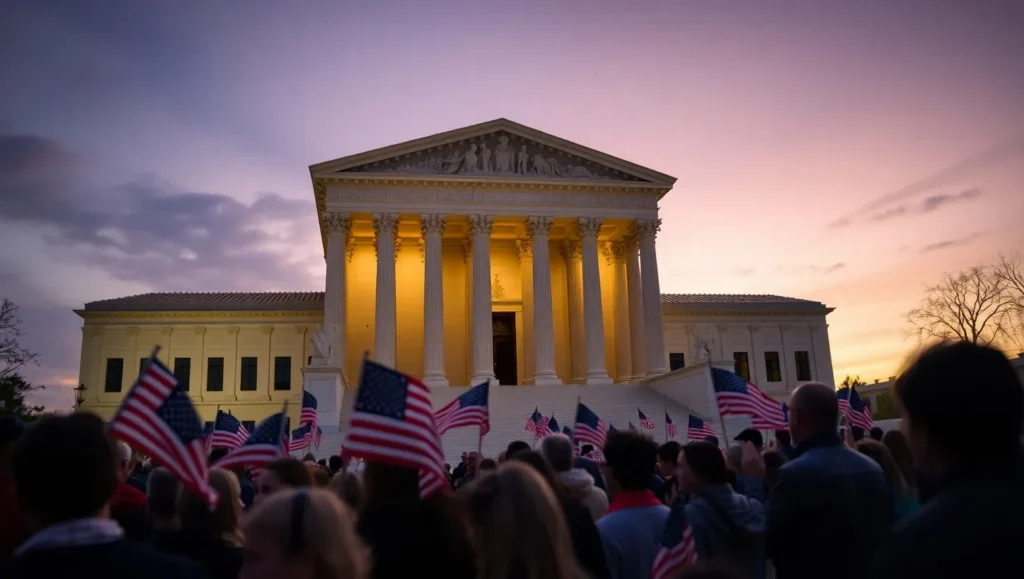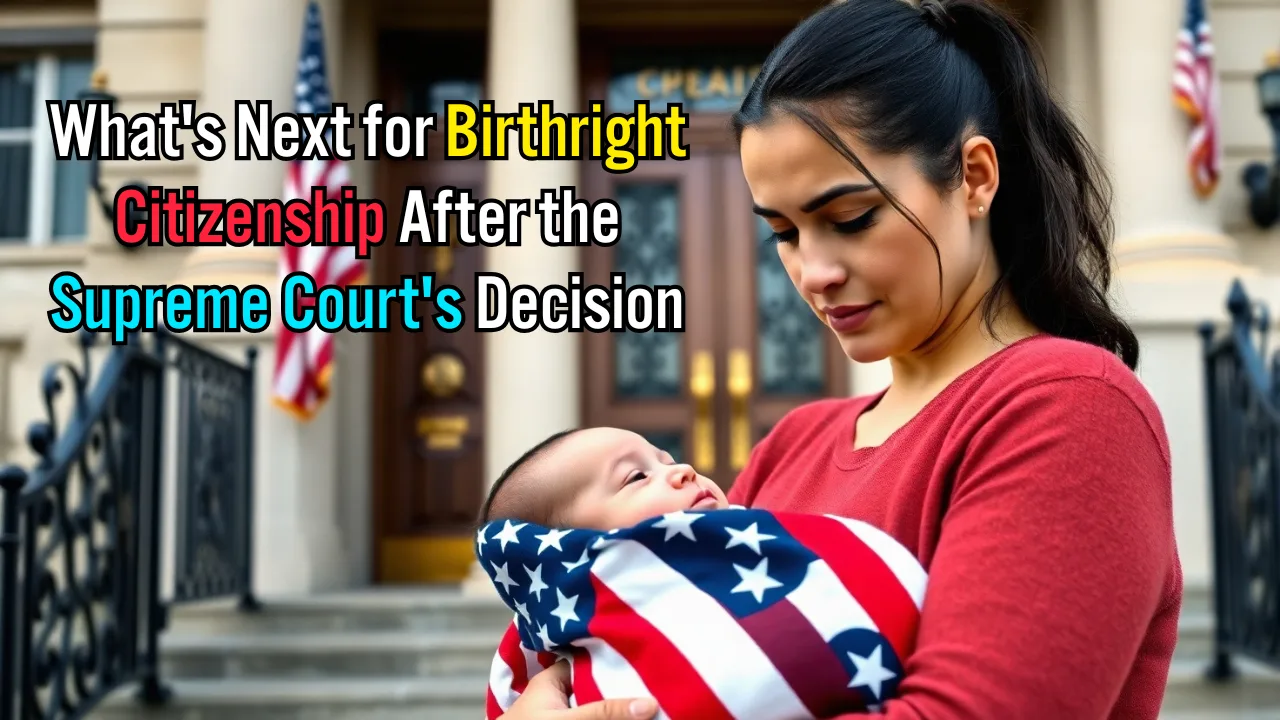Table of Contents
The conflict over President Donald Trump’s attempt to end birthright citizenship is far from finished, even after the Republican administration’s win on Friday that limited nationwide injunctions. Immigrant advocates are gearing up to fight hard to keep birthright citizenship intact as the Republican president tries to undo more than a hundred years of precedent. The top court’s ruling has put cases against the president’s birthright citizenship plans back into lower courts, leaving the future of this policy unclear.

Understanding Birthright Citizenship
Birthright citizenship is the idea that anyone born in the U.S. automatically becomes an American citizen, even if their parents are living in the country without legal permission. This practice started soon after the Civil War when the 14th Amendment was added to the Constitution to ensure Black people, including former slaves, were recognized as citizens. The amendment states, “All persons born or naturalized in the United States, and subject to the jurisdiction thereof, are citizens of the United States.”
A significant case came about 30 years later when Wong Kim Ark, born in the U.S. to Chinese parents, was denied entry back into the U.S. after traveling abroad. His case led to the Supreme Court confirming that the amendment guarantees citizenship to anyone born in the U.S., regardless of their parents’ legal status. Since then, it’s been a core part of U.S. law, with a few exceptions, like children of foreign diplomats born in the U.S.
Trump’s Agenda on Birthright Citizenship
In January, Trump signed an executive order aimed at denying citizenship to kids born to people living in the U.S. illegally or temporarily. This move is a part of his tough immigration agenda, as he sees birthright citizenship as attracting illegal immigration. Trump and his supporters highlight the amendment’s phrase “subject to the jurisdiction thereof,” arguing it lets the U.S. refuse citizenship to babies born to women in the country illegally. However, several federal judges have disagreed, blocking his order from being enforced.
“I’ve been on the bench for over four decades and this is as clear-cut a case as I’ve seen. This order is blatantly unconstitutional,” U.S. District Judge John Coughenour said in a Seattle hearing earlier this year. Over in Maryland, U.S. District Judge Deborah Boardman wrote that “the Supreme Court has strongly rejected and no court in the country has ever backed” Trump’s view on birthright citizenship.
Is Trump’s Order Legal?
The recent Supreme Court ruling was a big win for the Trump administration by limiting a single judge’s power to issue nationwide injunctions. The administration celebrated this as a big step in preventing individual district court judges from blocking the president’s priorities, especially in immigration. However, the Supreme Court didn’t decide whether Trump’s birthright citizenship order itself is legal.
“The Trump administration’s strategy clearly paid off—they focused on challenging the scope of relief rather than the judges’ decisions on the merits,” commented Loyola Law School professor Jessica Levinson. Attorney General Pam Bondi expressed confidence that the high court will eventually support the administration on the substance of the case.

What’s Next in the Legal Battle?
With cases challenging the birthright citizenship policy sent back to lower courts, judges there need to figure out how to follow the new ruling. The executive order remains paused for at least 30 days, granting time to sort out next steps. The possibility of getting national relief through class-action lawsuits is still on the table, with suits quickly filed in Maryland and New Hampshire to oppose Trump’s order.
Still, seeking nationwide relief through class actions is tricky, as courts have set many barriers over the years, stated Suzette Malveaux, a Washington and Lee University law professor. “A class action isn’t a simple workaround for not having nationwide relief,” noted Malveaux, who had advised against removing nationwide injunctions.
Justice Sonia Sotomayor, in her dissenting opinion, encouraged lower courts to swiftly handle such relief requests and judge cases quickly to enable a fast Supreme Court review of policies “challenging policies as blatantly unlawful and harmful as the Citizenship Order.” Critics of Trump’s order cautioned it could lead to inconsistent policies across different states, causing a confusing mess without nationwide relief.
“Birthright citizenship has been settled law for over a century,” said Krish O’Mara Vignarajah, CEO of Global Refuge, a nonprofit supporting refugees and migrants. “By denying lower courts the chance to enforce this right evenly, the Court has opened the door to chaos, inequality, and fear.”
Frequently Asked Questions (FAQs) About What’s Next for Birthright Citizenship After the Supreme Court’s Decision
What exactly did the Supreme Court rule?
The Court held in a 6–3 decision that lower federal courts generally lack the authority to issue “nationwide injunctions” blocking executive actions—in this case, President Trump’s order to curtail birthright citizenship. Instead, relief must be tailored to the parties before each court.
Did the Supreme Court decide whether Trump’s birthright citizenship order is constitutional?
No. The ruling addressed only the scope of nationwide injunctions, not the merits of the executive order itself. The question of whether the order violates the 14th Amendment remains pending in the lower courts.
What is a nationwide injunction, and why does it matter here?
A nationwide injunction is a court order that halts enforcement of a policy across the entire country. Critics argue it grants too much power to individual judges; proponents say it prevents harm to all affected parties at once. The Supreme Court’s decision means future challenges to federal rules—including this birthright citizenship order—must seek relief state by state or via class actions.
What exactly did Trump’s executive order propose?
Issued January 20, 2025, the order sought to deny U.S. citizenship to children born on American soil to parents who are in the country illegally or temporarily (e.g., tourists, students). Trump argued the 14th Amendment’s “subject to the jurisdiction thereof” clause allows such a reinterpretation.
How long is Trump’s order paused?
The Supreme Court left the existing injunctions in place for at least 30 days after its June 27, 2025 decision, giving lower courts time to determine if and how narrower injunctions should apply.
What happens next in the legal battle?
Cases challenging the order have been sent back to district courts, which must now decide whether to grant relief tailored to individual plaintiffs or classes. At least two new class‑action suits were filed in Maryland and New Hampshire aiming for nationwide relief under stricter procedural rules.
Could inconsistent rules emerge across different states?
Yes. Without nationwide injunctions, some courts might block the order for local plaintiffs while others allow limited enforcement elsewhere—potentially creating a patchwork where birthright citizenship applies differently by jurisdiction. Critics warn this could sow confusion and inequality.
Is a class-action lawsuit an easy workaround for nationwide relief?
No. While class actions can bind all similarly situated individuals, courts have imposed stricter certification requirements over the years, making it harder to obtain broad relief this way. Legal scholars caution it’s no simple substitute for universal injunctions.
Will the Supreme Court likely review the order’s constitutionality later?
Almost certainly. If lower courts reach conflicting conclusions on the merits, the issue is likely to return to the Supreme Court for a definitive ruling on whether the 14th Amendment bars the president from redefining birthright citizenship.
What broader implications does this decision have?
Beyond birthright citizenship, the ruling reshapes how federal courts can check executive power—limiting nationwide relief in challenges to immigration policies, environmental rules, health regulations, and more. Advocates on both sides predict a surge in piecemeal litigation and increased importance of class‑action strategies.

1 thought on “What’s Next for Birthright Citizenship After the Supreme Court’s Decision 2025”